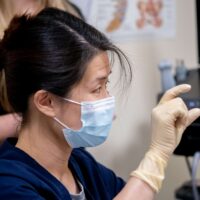Cervical spine surgery is rarely the first option for treating neck pain but can be very effective in relieving relieving pressure on the spinal cord or spinal nerves that is causing neck pain and/or arm pain.
If you have tried six months of conservative treatments, such as physical therapy and pain management procedures, your spine surgeon may want to discuss surgery to treat your neck pain and/or arm pain. Cervical spine surgery is used to relieve pain caused by herniated or ruptured discs, spinal stenosis, facet degeneration, or spondylolisthesis that is putting pressure.
Anterior cervical discectomy and fusion (ACDF) is the most common procedure to treat herniated cervical discs. Artificial disc replacement surgery is a newer procedure, but it offers many benefits over ACDF for the right patients. Neurosurgery One Denver spine surgeons perform more than half of spine surgeries today on an outpatient basis. This means you’ll be home the same day. Our spine surgeons also perform many cervical spine surgeries using minimally invasive techniques that result in less pain and faster recovery.
FAQs About Neck Surgery
Continue reading below to learn more about neck surgery, or click on one of these links to go directly to the information that interests you.
- What are the different types of neck surgery?
- What are spinal decompression and fusion surgeries?
- What is anterior cervical discectomy and fusion (ACDF) surgery?
- What is artificial disc replacement surgery?
- How do you choose a spine surgeon?
- How do you choose a hospital for spine surgery?
- How do you prepare for cervical spine/neck surgery?
- What is the recovery process for cervical spine/neck surgery?
Conditions We Treat
What are the different types of neck surgery?
When surgery is necessary to relieve neck pain, it’s important to choose neurosurgeons with the experience necessary to effectively treat your pain, with the procedure appropriate for your particular condition. The expert neurosurgeons at Neurosurgery One perform 300-400 spine surgeries each year — more than many neurosurgeons perform over several years — successfully reducing pain and restoring activity for our patients. Whenever possible, we use minimally invasive spine surgery techniques to help you recover faster and with less pain. We also utilize robotic guidance to ensure the highest possible level of accuracy. And we are skilled in a variety of cervical spine procedures, which assures that we can provide the best possible surgical option, and the optimal outcome, for each patient.
Our surgical specialties include:
What are spinal decompression and fusion surgeries?
Two common types of surgical procedures that relieve neck pain are spinal decompression and spinal fusion.
Spinal decompression involves removal of tissue that is causing pain by pressing against a nerve.
Some types of decompression surgery include:
- Transcorporeal Microdecompression creates a small channel in the vertebral body. This channel provides access to the spinal cord and nerve. This allows the neurosurgeon to restore normal space in the spinal cord and nerve while preserving the disc.
- Cervical laminectomy removes the lamina to enlarge the spinal canal and relieve pressure caused by spinal stenosis (the narrowing of the spinal canal).
- Cervical laminotomy removes just part of the lamina.
- Cervical laminoplasty cuts through the lamina to create space in the spinal canal. Bone is then reconnected with small plates to enlarge the overall dimension of the canal.
- Foraminotomy removes bone spurs or other material that is pressing on a nerve.
- Facetectomy removes the facet, the small joints between each vertebra, to reduce pressure on a nerve.
Spinal fusion, including cervical spinal fusion surgery, is a type of spine surgery where plates, screws, bones, or other materials are used to stabilize the spine by limiting motion between vertebrae. Spine fusion is the most commonly performed surgery for displaced discs in the neck, with around 775,000 performed annually in the United States.
What is anterior cervical discectomy and fusion (ACDF) surgery?
The most common type of cervical fusion procedure, ACDF, removes damaged vertebrae and intervertebral discs that are compressing the spinal cord and/or spinal nerves. Neurosurgery One performs this surgery with a minimally invasive technique through one small incision at the front of the neck, through which the neurosurgeon removes the degenerated or herniated disc. The space left by the absent disc is then filled with bone or other material to prevent the vertebrae from collapsing and rubbing together. The material serves as a bridge between the two vertebrae to create a spinal fusion. The bone graft and vertebrae are fixed in place with metal plates and screws. After surgery, new bone cells will grow around the graft, as part of the body’s natural healing process. After three to six months, the two vertebrae should be joined together as one solid piece of bone to provide greater stability to the cervical spine.
Read more about anterior cervical discectomy and fusion surgery.
What is artificial disc replacement surgery?
Artificial disc replacement surgery is a newer procedure that offers many benefits for the right patients. Artificial disc replacement surgery is a minimally invasive procedure, resulting in less pain and faster recovery. Disc replacement also offers the benefits of increased neck movement following surgery.
In artificial cervical disc replacement surgery, a one-inch incision is made, most often in the neck fold, and the degenerated or herniated disc is removed. Once the disc is removed, a new disc, specifically sized to fit the patient, is inserted. Many artificial discs consist of two metal end plates separated by a polyethylene — or plastic — spacer. With artificial disc replacement surgery, most patients are discharged from the hospital within 24 hours.
Benefits of artificial disc replacement include:
- Maintains full range of neck motion
- Reduces the likelihood of degeneration in adjacent segments of the cervical spine
- Eliminates the potential complications associated with bone graft used in ACDF surgery
- Shorter recovery time; most patients are able to resume normal activities within a few weeks
- Most patients can resume full activity, including vigorous activities, such as jogging, in as soon as three months
Read more about cervical artificial disc replacement surgery.
How do you choose a spine surgeon?
If you are considering surgery to relieve your neck and/or arm pain, choosing your spine surgeon is one of the most important decisions you can make. Both orthopedic surgeons and neurosurgeons can perform spine surgery. But choosing a neurosurgeon offers unique expertise and benefits.
Neurosurgeons, like those at Neurosurgery One, offer the following:
- Have two years more training than most orthopedic surgeons
- Typically perform more spinal procedures during their residency than orthopedic surgeons
- Have expertise in dealing with nerves and spinal cord, critical components of any surgery involving the cervical spinal cord or cervical spine area
When choosing a spine surgeon, you should consider these factors:
Experience. While there is no magic number for this, most experts agree that an “experienced” surgeon is one who: (1) has five years’ experience performing the procedure; (2) has performed the procedure at least 30 times. Some neurosurgeons also complete special spine fellowships that give them additional training and experience specifically in spine surgery.
Outcomes. Benefits of a more experienced surgeon include reduced surgical complication rates, lower infection rates, shorter hospital stays, more careful patient screening, and less chance a patient will need additional surgeries or revision surgery.
Board certification. This means that a physician or surgeon meets nationally accepted standards for knowledge and practice, enabling the optimal quality of care to be maintained. If a spine surgeon is a neurosurgeon, he or she may be board-certified by the American Board of Neurological Surgery. Orthopedic surgeons who perform spine surgery may be certified by the American Board of Orthopaedic Surgery. Both of these certifying bodies are member boards of the American Board of Medical Specialties. Surgeons must actively treat patients for a certain number of years after they complete their education before they are eligible to become board certified, so younger surgeons may not yet have board certification but are highly qualified to perform surgery based on their experience through their education.
In addition to experience and training, it’s important that patients feel comfortable with the surgeon and office staff.
How do you choose a hospital for spine surgery?
As part of your research into selecting a spine surgeon, you also should consider where the surgeon will perform your surgery. Some spine surgeries are performed in outpatient surgical centers, while others are performed in a hospital as either outpatient or inpatient surgery.
Researching a hospital is important because, depending on the surgery you’ll be having, you may have to stay in the hospital one or more nights. Factors such as whether the hospital has a specialized unit for spine surgery, nursing staff training in caring for spine surgery patients, and even things like the hospital’s quality scores and rates of hospital-acquired infections, may all affect your surgical outcomes.
Some factors you should consider when choosing a hospital include:
- Does the hospital have a special inpatient unit, area, or floor for spine surgery?
- If yes, what training do the spine unit nurses receive in caring for spine surgery patients?
- How many spine surgeries are performed at the hospital each year?
- What are the hospital’s overall quality scores for patient outcomes, such as surgical site infections, hospital-acquired infections (e.g., MRSA, etc.), and hospital readmissions? This article from Consumer Reports includes a list of resources and links where you can research hospital quality ratings, including Hospital Compare, The Joint Commission, and The Leapfrog Group.
- Does the hospital have Magnet status for nursing? Magnet hospitals tend to have more engaged nurses, lower RN turnover, and better quality outcomes than non-Magnet hospitals.
- Are other patients satisfied with the care they received? Medicare’s Hospital Compare ratings include data on patient satisfaction.
- Is the hospital included in your insurance plan?
How do you prepare for cervical spine/neck surgery?
Preparing for surgery is very important and has a direct impact on your recovery after surgery. At Neurosurgery One, we use a unique and in-depth program that offers our patients in-depth education about how to prepare for and recovery from spine surgery. At Neurosurgery One, your spine surgery care team will work closely with you before your procedure to answer all your questions, address your concerns, and assure that you have all the information you need to make your surgery successful, including advice on:
- Stopping certain medications such as nonsteroidal anti-inflammatory drugs (NSAIDs), aspirin, or blood thinners
- Talking with your primary care provider about other medical conditions and medications
- Stopping smoking or using other tobacco products
- Preparing your home for return after surgery, including lining up caregivers and meals, and removing tripping hazards
- Preparing for the day of surgery
What is the recovery process for cervical spine/neck surgery?
Your recovery from cervical spine surgery will depend on many factors, including your overall health before surgery, and the type of procedure you have. Before your surgery, our care team will discuss what you can expect during the days and weeks after surgery and will be happy to answer any questions you may have. Every patient’s experience with recovery and rehabilitation is different. But in general, most patients are able to go home within a few days after surgery. Before leaving the hospital, you may work with physical therapists and occupational therapists so that you will be comfortable getting in and out of bed and walking after going home. You’ll typically have a follow-up visit within two weeks of surgery.
After most types of surgery, you may expect to:
- Return to work three or four weeks after surgery
- Resume driving three to six weeks after surgery, if you’re able to turn your neck, and no longer need pain medications that could impair your driving
- Be advised to avoid bending and twisting the neck for several weeks
- Be advised to avoid lifting heavy objects in the first four to six weeks
- Resume low-impact sports in six to eight months
Read Our Blogs About Neck Pain

- Are there any permanent restrictions with a spinal cord stimulator?
- Can diabetic neuropathy be reversed?
- Is Cracking Your Neck Bad? Understanding the Potential Risks and Benefits
- Life After ACDF Surgery: Understanding Permanent Restrictions
- Should I see a physician assistant vs doctor for my back pain treatment?
- When to Go to the ER for Back Pain




